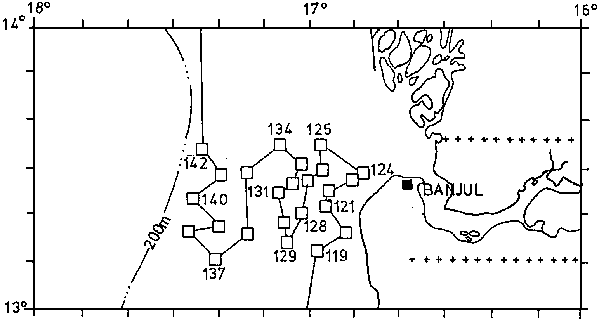During the activities of R/V "Dr. Fridtjof Nansen" in the waters off North-Vest Africa in August - September 1986 a request to undertake a trawl survey in Gambian waters was received from the Department of Water Resources, Gambia. It was decided to spend two days for such activities before the vessel proceeded northwards to Mauritania.
The scientific staff was:
From Guinea-Bissau :
Augusto P. J. SilvaFrom Gambia:
Joseph NdeneThe vessels own scientific staff was:
Anna Lloyd Evans
Tore StrømmeThe results
Alvaro Abella
Kjell Strømsnes
Terje Haugland
Erling Molvær
The stations were set out semi-randomly and the cruise track together with the fishing stations are shown in Figure 1.
24 hauls were carried out of which some were worked after sunset. Records of the fishing stations are shown in Annex I with the main species in the catch given. Complete records of the catches have been handed over to the Ministry of Water Resources.
A first analysis of the catch records gives an estimated density of 11.7 tonnes per nm2 of demersal fish within the 200 meter depth contour. Subdivided on bottom depth strata the estimated densities are 11.1 tonnes/nm2 for the 10-30m bottom depth stratum, and 12.5 tonnes/nm2 for the 30-200m zone.
The area of the Gambian shelf was calculated to 1410 nm2 by planimetry, and estimated absolute abundances are obtained by multiplying the area with the densities estimated. This gives abt 16500 tonnes for the shelf to 200m.
In these calculations a catchability coefficient of 1.0 has been applied. This means that all fish within the path of the trawl are assumed caught. In bottom trawl surveys coefficients within the range 0.5 to 1.0 are common. A coefficient equal to 0.5 would double the estimates given above. Our estimate therefore tends to give conservative but from a management point of view safer assessment of the resources.
An extraordinary high catch of 11.5 tonnes per hour (st. no. 121) was not included in the calculations as this catch is probably not representative for the true catch distribution. (Anyhow this catch was mainly composed of silverside grunt with a very low commercial value.)
A detailed analysis of the species composition in the hauls from the trawl survey in Gambia has been made. The species composition is as follows: (% of total catch)
|
Silverside grunt (Brachydeuterus auritus) |
: 46 |
|
Red pandora (Pagellus bellottii) |
: 14 |
|
Lesser african threadfin (Galeoides decadactylus) |
: 6 |
|
Streaked gurnard (Chelidonichthys lastoviza) |
: 5 |
|
Parrot grunt (Pomadasys peroteti) |
: 2 |
|
Atlantic bigeye (Priacanthus arenatus) |
: 2 |
|
West African goatfish (Pseudupeneus prayensis) |
: 2 |
|
Spanish mackerel (Scomberomorus tritor) |
: 2 |
|
Other demersal species, (< 2% each
species) |
: 25 |
The catches of shrimp are less than 1% of the total catch of the trawl survey. However the survey was not designed to assess the biomass of shrimps in Gambian waters. Most of the shrimps seems to be allocated in a narrow depth zone along the coast and much more intensive sampling in that area should be done to assess these resources.
Figure 1. Cruise track with trawl stations.
